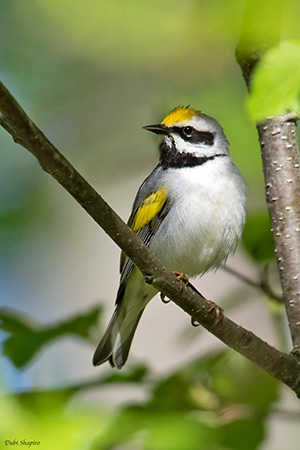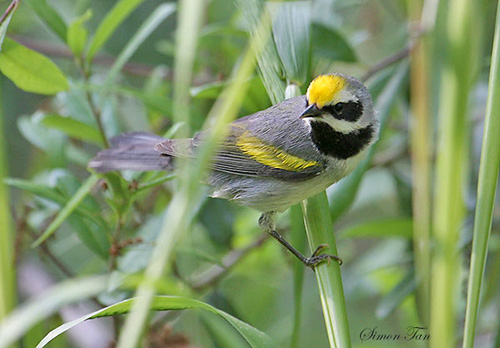
PROTECTION / THREATS / STATUS:
The Golden-winged Warbler is threatened by changes in the habitat such as reforestation, and loss of wintering habitats (forest edge and open woodland) caused by clearing for agriculture expansion.
Nest parasitism by the Brown-headed Cowbird, and hybridisation with the Blue-winged Warbler are also important problems.
The size of the population is unknown, but it has decreased rapidly in recent decades.
The species is not yet officially endangered, but the Golden-winged Warbler is currently classified as Near Threatened.
Fr: Paruline à ailes dorées
Ang: Golden-winged Warbler
All: Goldflügel-Waldsänger
Esp: Reinita Alidorada
Ita: Parula alidorate
Nd: Geelvleugelzanger
Sd: guldvingad skogssångare
Photographers:
Dubi Shapiro
Dubi Shapiro Photo Galleries
Simon Tan
PBase Bird galleries
Text by Nicole Bouglouan
Sources:
HANDBOOK OF THE BIRDS OF THE WORLD Vol 15 by Josep del Hoyo-Andrew Elliot-David Christie - Lynx Edicions – ISBN: 9788496553682
A GUIDE TO THE BIRDS OF MEXICO AND NORTHERN CENTRAL AMERICA by Steve N. G. Howell, Sophie Webb - Oxford University Press - ISBN: 0198540124
FIELD GUIDE TO THE BIRDS OF NORTH AMERICA – National Geographic Society - ISBN: 0792274512
Golden-winged Warbler: Conservation Strategy and Resources
Animal Diversity Web (University of Michigan Museum of Zoology)
Houston Audubon Society (National Audubon Society)
Virginia Department of Wildlife Resources
Department of Environmental Conservation
Status and Conservation Priorities of Golden-Winged Warbler (Vermivora Chrysoptera) in North America
Wikipedia, the free encyclopaedia
Golden-winged Warbler
Vermivora chrysoptera
Passeriformes Order – Parulidae Family
INTRODUCTION:
The Golden-winged Warbler is found in E and NC parts of the United States and S Canada. After breeding, it migrates S into Mexico, N South America and the Caribbean.
It breeds in shrubby habitats and is often present in wetland areas, whereas in winter, it lives mainly in open woodland and forest edges. It feeds primarily on insects and various arthropods.
During the breeding season, the Golden-winged Warbler hybridizes with the Blue-winged Warbler.
Male and female are monogamous with some rare exceptions. The female builds the nest, an open cup-shaped structure near or on the ground, well-hidden among the foliage. Both parents feed the young.
The Golden-winged Warbler is affected by degradation and loss of the habitat, both in breeding and wintering ranges. The population is declining, especially over the past 15 years. The specie is currently classified as Near Threatened.
DESCRIPTION OF THE BIRD:
Biometrics:
Length: 12-13 cm
Weight: 8-9 g
The Golden-winged Warbler adult male has grey upperparts and hindneck. On the upperwing, the flight-feathers are darker with conspicuous yellow wing patch. The secondaries are edged olive. The tail feathers have darker centres, and we can see large white spots on the outer three rectrices.
The underparts are pale greyish-white, darker grey on flanks.
On the head, the crown is bright yellow, whereas wide supercilium and moustache are white. We can see a contrasting black mask extending from lores to ear-coverts. The throat (bib) is black too.
Bill, legs and feet are blackish. The eyes are dark brown.

The adult female (not displayed) resembles male but she is duller, including the face pattern. Both auricular mask and throat are grey. The forecrown is greenish-yellow.
The grey upperparts are tinged olive and the wing panel is reduced.
The underparts are duller, mostly greyish-white.
The juvenile has olive-grey crown, nape and upperparts. On the upperwing, we can see creamy wingbars (not yellow) on greater and median upperwing coverts. The underparts are pale olive-yellow with dusky throat.
The 1st year resembles adult, but with broad olive fringes on tertials.
RANGE:
The Golden-winged Warbler breeds from SE Manitoba to N Minnesota and Wisconsin E to S Ottawa, New York and Vermont, and also throughout Michigan.
The breeding range extends into the Appalachian Mountains, as far as E Tennessee, W North Carolina and N Georgia.
The Golden-winged Warbler migrates after the breeding season to spend the winter far south to Central America, from Belize and Guatemala, S to N South America in N Colombia and W Venezuela.
The species can also be seen in Cuba, Puerto Rico and Cayman Islands.
HABITAT:
The Golden-winged Warbler breeds in brushy areas with weeds, shrubs and some trees, especially alders and pines. This type of habitat is found in abandoned cultivated fields and clearings when the vegetation is growing up to woods again.
The species is found between 180 and 1,500 metres of elevation.
It also frequents wetland habitats, and some observations indicate that the young birds move into mature forests after fledging. This habitat is a good protection against predators like hawks.
In the wintering range, the species frequents forest edges and open woodland.
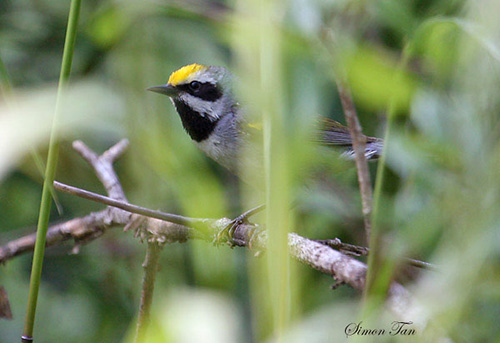
CALLS AND SONGS: SOUNDS BY XENO-CANTO
The Golden-winged Warbler male has two types of songs. The first one is a two syllable song including a high-pitched “zee” followed by up to six “bee” notes. It is described as “bee-bz-bz-bz”. This song is used by the male to attract a female.
The second song includes 3-5 syllables ending in a “buzz” note. This song is used by the male while interacting with rivals, also during the flight displays or at dawn before sunrise.
Both male and female use the call “tzip” as contact call to attract each other during the breeding period.
BEHAVIOUR IN THE WILD:
The Golden-winged Warbler feeds on insects and arthropods. The diet includes caterpillars, moth larvae, various insects and spiders.
It forages among the foliage in the upper level of trees and shrubs in summer. It probes and picks among the vegetation, and sometimes hangs upside-down.
The Golden-winged Warbler forages sometimes with the Black-capped Chickadee, both on breeding areas and during migration.
During winter, it feeds fairly low in trees, often in mixed-species flocks.
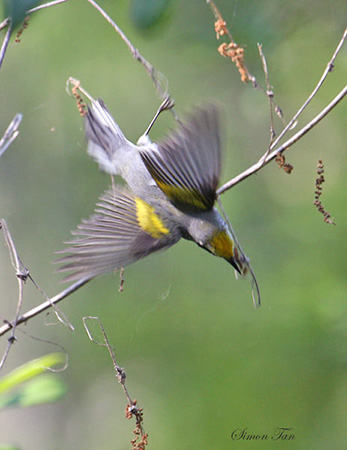
The Golden-winged Warbler is territorial, and during the breeding season, several encounters with other males are observed. The territorial male raises the crown feathers and spread the tail, in order to enhance the bright yellow feathers of the crown, and the white patches of the tail. Chasing and fighting are also reported.
The Golden-winged Warbler and the Blue-winged Warbler have overlapping territories. They hybridize because they have fairly similar plumage and song.
The hybrids are known as Brewster’s Warbler and Lawrence’s Warbler.
At the beginning of the breeding season, the male defends the territory by singing. It arrives in May on the territory, some days before the females. It performs courtship displays to attract a mate. The male chases the female, raises the crown feathers to expose the bright-yellow feathers, and performs an aerial display during which it flies with slow wingbeats while flying away. But when it flies towards the female, the flight becomes a glide. Chases may occur too.
Both adults feed the young, but the nest is built by the female.
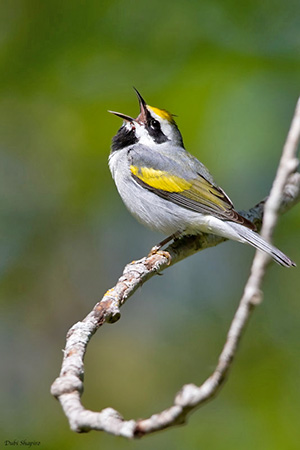
The Golden-winged Warbler moves S to Central America and N South America after breeding. It probably migrates mostly at night.
The Golden-winged Warbler performs some aerial displays, flying slowly with marked wingbeats. But glides are also observed when the male flies towards the female, prior to chase her.
REPRODUCTION OF THIS SPECIES:
The breeding season takes place from May to July.
The Golden-winged Warbler is one of a few Parulidae species that nests on or near the ground.
The female builds the open, cup-shaped nest at base of shrub, or in tussock of grass or sedge, using the stem for support. The site is usually well-hidden among the vegetation. The nest is made of leaves, grapevine bark and long strips of grass. The cup is lined with finer plant material, occasionally with animal hair or fur.
The female lays 4-7, usually 4-5, pale cream or pink eggs with brown and lilac markings. She incubates alone during 10-11 days, and the chicks leave the nest 8-10 days after hatching. They are fed by both parents for up to another month.
This species produces a single brood per year.
After fledging, the young birds move to adjacent mature forests where they feed on caterpillars and various insects.
The nest of the Golden-winged Warbler is parasitized by the Brown-headed Cowbird, reducing hatching success by 50%, and fledging success by 17%, compared with non-parasitized nests.
